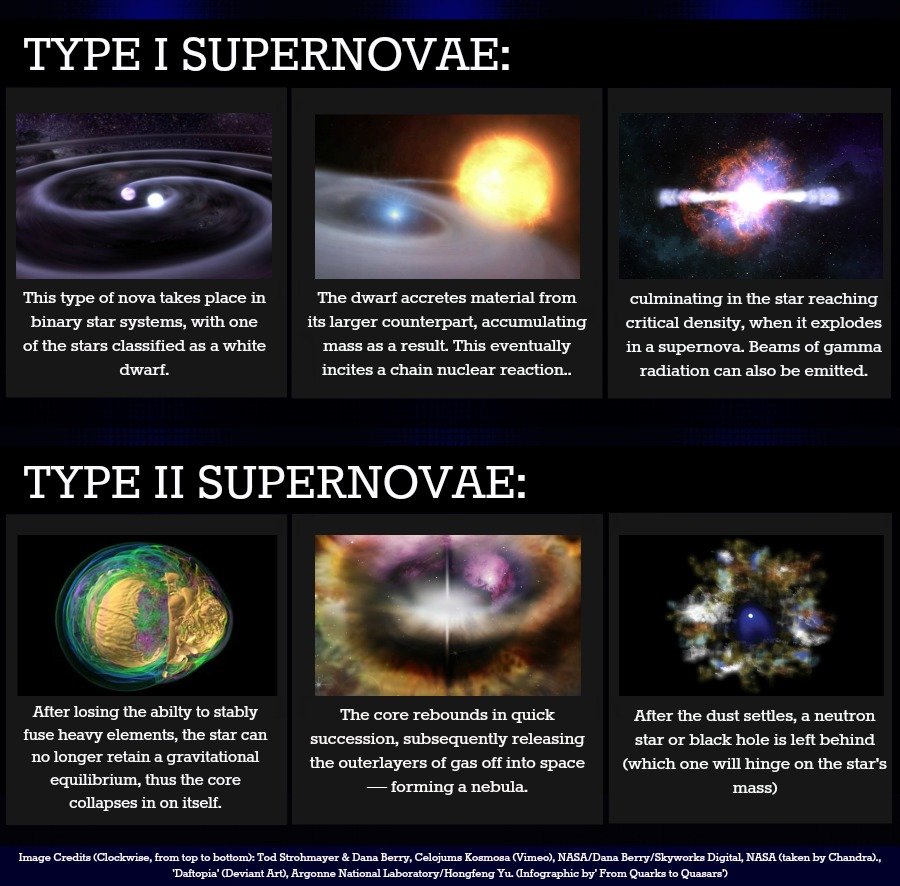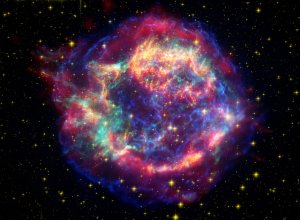

Supernovae – the Earth-shattering ‘kabooms’ – are magnificent stellar displays that provide us with a plethora of useful scientific information about many facets of the universe. They are also awe-inspiring to look at after-the-fact; proving that destruction can gave birth to unadulterated beauty! But have you ever wondered about the inner workings of these colossal explosions?
Thanks to the tireless work of many different space agencies, astronomers now have at their disposal several well developed theories about what makes stars explode. These theories, as well as many years worth of’ observation data collected of supernovae in far-distant galaxies, help divide all supernovae explosions into two main types; know as Type I and Type II supernovae. According these classifications, stars that explode do so for two primary reasons. Either they act as celestial parasites – siphoning material from their neighbors; until they spark the ignition of a nuclear chain reaction, or because they cannot sustain gravitational equilibrium (this happens after a massive star consumes the bulk of ts fuel for fusion). Those are the basics, but let’s delve into how each nova is classified, starting with Type I.
TYPE 1A SUPERNOVAE:
Type Ia supernovae are thought to arise from white dwarf stars. By itself, a white dwarf can produce no explosion, but if a nearby star – for example, a companion star that is effectively in orbital cohorts with the white dwarf – deposits a sufficient amount of material onto the shrunken star, the white dwarf has a new source of fuel.

The white dwarf’s immense gravity causes this new material to fall onto the surface of the white dwarf, coating it with a nuclear manna that has the potential to release more energy through nuclear fusion than normal. For a time, nothing happens. The in-falling material accumulates on the white dwarf’s surface, until a chain nuclear reaction ignites. After which, the star will enjoy a brief final moment of incandescent splendor , until it blows itself completely apart.
TYPE II SUPERNOVAE:
The second type of supernovae – Type II, will take place in the final stage in the evolution of a massive star (stars with a mass equal to ten or twenty times the mass of our sun qualify). These high mass stars are relatively uncommon; in fact our own Sun has more mass than 90% of all stars. Astronomers have calculated how a star with ten or twenty times the sun’s mass will contract its central core as it ages, raising the temperature there to help fuse heavier nuclei.
As the star heads for its rendezvous with its destructive destiny, it desperately seeks additional ways to generate more heat through nuclear fusion, without which, the star will collapse under its own gravity. As a part of this collapse, more heat is generated within the star’s core as helium nuclei turn into carbon and oxygen, then carbon and oxygen nuclei into neon and magnesium, then neon and magnesium into silicon and sulfur, and then finally silicon and sulfur into nickel and iron – this generates outward pressure to counteract the gravity pulling it inwards. But the struggle for more energy must eventually fail and the star’s core must collapse, unable to support itself against its own gravitation. The collapse stops when the core becomes an immensely dense neutron star. The neutron star forms with an outward bounce that sends a fast-moving shockwave through the star’s outer layers; blowing them into space in the violent and glowing event we call a supernova.
THE ART OF SUPERNOVAE:
The very act by which a supernova attracts our attention – the outbursts that makes it explode and emit enormous amounts of light – destroys our chance to study the pre-supernova star in detail. Hence our ability to distinguish between Type I and Type II supernovae rests not on our observations of a star’s appearance before its explosion, but rather on astronomers’ models of how stars explode, as well as from their observations of the actual explosions and the type of galaxies in which supernovae appear. To discriminate between Type I and Type II explosions, astronomers spread the supernovae’s light into its various colors in a spectrograph and analyze it, color by color.

This analysis reveals two important facts about the material ejected from the exploding star; the types of elements it contains, and the speed at which the material is moving away from the star. From their observations, astronomers have found that Type II supernovae eject large amounts of hydrogen gas into space at enormous velocities, ten thousand miles per hour or more. In contrast, Type I supernovae show no such fast-moving hydrogen, presumably because the stars that become Type I supernovae have already expelled their hydrogen-rich outer layers into space during their red giant phase, and turned all the hydrogen in their cores into other elements through nuclear fusion.
To validate the distinctions that they make between Type I and Type II supernovae – Type I arising from white dwarfs with companions, Type II from massive stars that finally give up the fight and collapse – astronomers would dearly love to observe a supernova before it explodes, if only to find out whether these theories of supernova explosions have any basis n fact. Although they have yet to do so as carefully as they would like, the supernova of 1987 brought astronomers closer to this goal than ever before. As usual, however, in doing so, the supernova introduced more mysteries than it resolved!
Find this interesting? Read all about the star that flipped itself inside out during the final throes of its life.